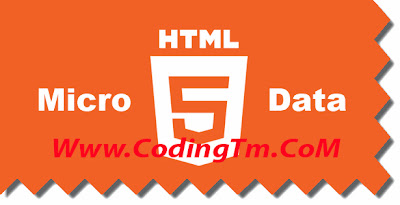Microdata is a standardized way to provide additional semantics in your web pages.
Microdata lets you define your own customized elements and start
embedding custom properties in your web pages. At a high level,
microdata consists of a group of name-value pairs.
The groups are called
items, and each name-value pair is a
property. Items and properties are represented by regular elements.
Example:
- To create an item, the itemscope attribute is used.
- To add a property to an item, the itemprop attribute is used on one of the item's descendants.
Here there are two items, each of which has the property "name":
<div itemscope>
<p>My name is <span itemprop="name">Zara</span>.</p>
</div>
<div itemscope>
<p>My name is <span itemprop="name">Nuha</span>.</p>
</div>
|
Properties generally have values that are strings but it can have following data types:
Global Attributes:
Microdata introduces five global attributes which would be available
for any element to use and give context for machines about your data.
| Attribute | Description |
|---|
| itemscope | This is used to create an item. The itemscope
attribute is a boolean attribute that tells that there is Microdata on
this page, and this is where it starts. |
| itemtype | This attribute is a valid URL which defines the item and provides the context for the properties. |
| itemid | This attribute is global identifier for the item. |
| itemprop | This attribute defines a property of the item. |
| itemref | This attribute gives a list of additional elements to crawl to find the name-value pairs of the item. |
Properties Datatypes:
Properties generally have values that are strings as mentioned in
above example but they can also have values that are URLs. Following
example has one property, "image", whose value is a URL:
<div itemscope>
<img itemprop="image" src="tp-logo.gif" alt="TutorialsPoint">
</div>
|
Properties can also have values that are dates, times, or dates and times. This is achieved using the
time element and its
datetime attribute.
<div itemscope>
My birthday is:
<time itemprop="birthday" datetime="1971-05-08">
Aug 5th 1971
</time>
</div>
|
Properties can also themselves be groups of name-value pairs, by
putting the itemscope attribute on the element that declares the
property.
Microdata API support:
If a browser supports the HTML5 microdata API, there will be a
getItems() function on the global document object. If browser doesn't
support microdata, the getItems() function will be undefined.
function supports_microdata_api() {
return !!document.getItems;
}
|
Modernizr does not yet support checking for the microdata API, so you’ll need to use the function like the one listed above.
The HTML5 microdata standard includes both HTML markup (primarily for
search engines) and a set of DOM functions (primarily for browsers).
You can include microdata markup in your web pages, and search
engines that don't understand the microdata attributes will just ignore
them. But if you need to access or manipulate microdata through the DOM,
you'll need to check whether the browser supports the microdata DOM
API.
Defining Microdata Vocabulary:
To define microdata vocabulary you need a namespace URL which points
to a working web page. For example http://data-vocabulary.org/Person can
be used as the namespace for a personal microdata vocabulary with the
following named properties:
- name - Person name as a simple string
- Photo - A URL to a picture of the person.
- URL - A website belonging to the person.
Using about properties a person microdata could be as follows:
<section itemscope itemtype="http://data-vocabulary.org/Person">
<h1 itemprop="name">Andy Runie</h1>
<p>
<img itemprop="photo" src="http://www.example.com/photo.jpg">
</p>
<a itemprop="url" href="http://www.example.com/blog">My Blog</a>
</section>
|
Google supports microdata as part of their Rich Snippets program.
When Google's web crawler parses your page and finds microdata
properties that conform to the http://data-vocabulary.org/Person
vocabulary, it parses out those properties and stores them alongside the
rest of the page data.

 07:41
07:41
 Unknown
Unknown

 Posted in
Posted in







0 comments :
Post a Comment